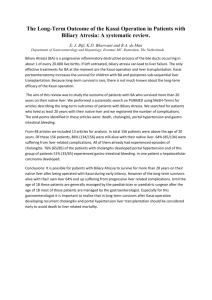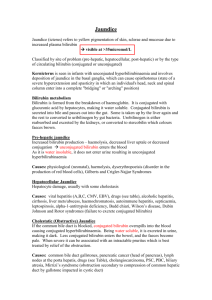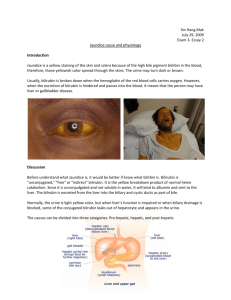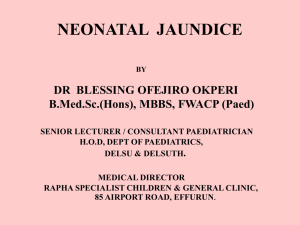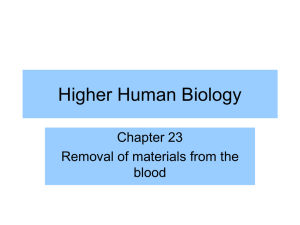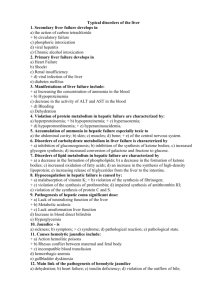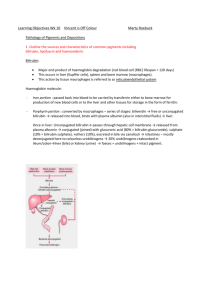Biliary Atresia Case Study: Nursing Care Plan
advertisement
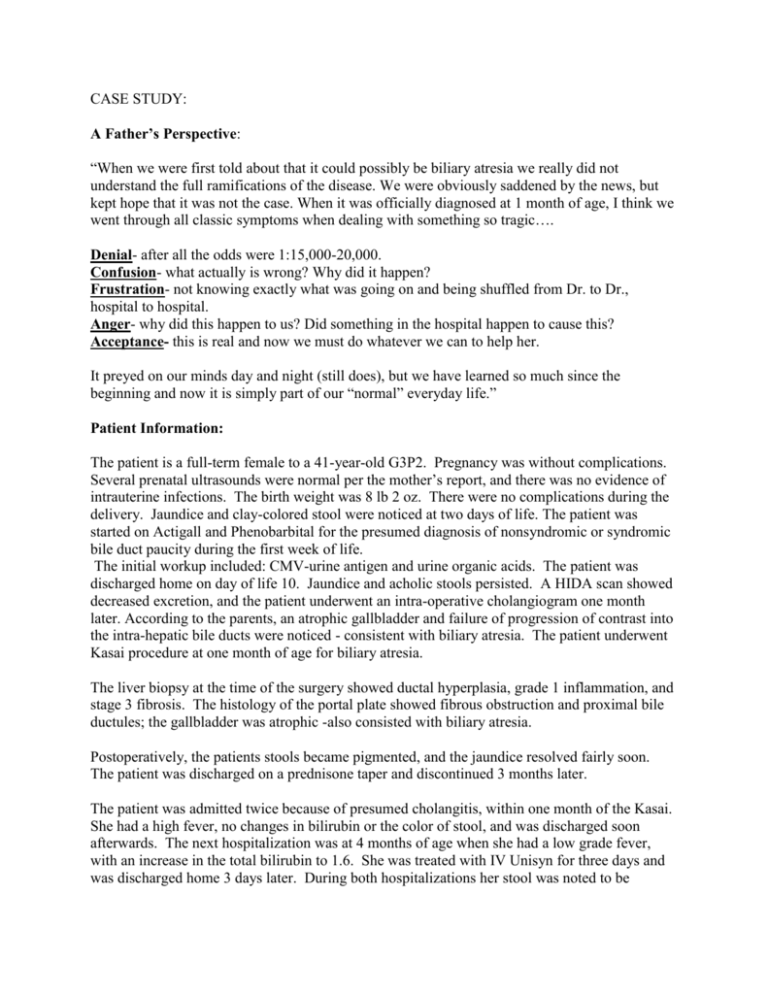
CASE STUDY: A Father’s Perspective: “When we were first told about that it could possibly be biliary atresia we really did not understand the full ramifications of the disease. We were obviously saddened by the news, but kept hope that it was not the case. When it was officially diagnosed at 1 month of age, I think we went through all classic symptoms when dealing with something so tragic…. Denial- after all the odds were 1:15,000-20,000. Confusion- what actually is wrong? Why did it happen? Frustration- not knowing exactly what was going on and being shuffled from Dr. to Dr., hospital to hospital. Anger- why did this happen to us? Did something in the hospital happen to cause this? Acceptance- this is real and now we must do whatever we can to help her. It preyed on our minds day and night (still does), but we have learned so much since the beginning and now it is simply part of our “normal” everyday life.” Patient Information: The patient is a full-term female to a 41-year-old G3P2. Pregnancy was without complications. Several prenatal ultrasounds were normal per the mother’s report, and there was no evidence of intrauterine infections. The birth weight was 8 lb 2 oz. There were no complications during the delivery. Jaundice and clay-colored stool were noticed at two days of life. The patient was started on Actigall and Phenobarbital for the presumed diagnosis of nonsyndromic or syndromic bile duct paucity during the first week of life. The initial workup included: CMV-urine antigen and urine organic acids. The patient was discharged home on day of life 10. Jaundice and acholic stools persisted. A HIDA scan showed decreased excretion, and the patient underwent an intra-operative cholangiogram one month later. According to the parents, an atrophic gallbladder and failure of progression of contrast into the intra-hepatic bile ducts were noticed - consistent with biliary atresia. The patient underwent Kasai procedure at one month of age for biliary atresia. The liver biopsy at the time of the surgery showed ductal hyperplasia, grade 1 inflammation, and stage 3 fibrosis. The histology of the portal plate showed fibrous obstruction and proximal bile ductules; the gallbladder was atrophic -also consisted with biliary atresia. Postoperatively, the patients stools became pigmented, and the jaundice resolved fairly soon. The patient was discharged on a prednisone taper and discontinued 3 months later. The patient was admitted twice because of presumed cholangitis, within one month of the Kasai. She had a high fever, no changes in bilirubin or the color of stool, and was discharged soon afterwards. The next hospitalization was at 4 months of age when she had a low grade fever, with an increase in the total bilirubin to 1.6. She was treated with IV Unisyn for three days and was discharged home 3 days later. During both hospitalizations her stool was noted to be pigmented. However, two days after the discharge, the parents noticed recurrence of claycolored stool which was accompanied by the acute onset of jaundice. The first day the total bilirubin was 5.8 and the next the total bilirubin was 6.6. Medications at the time were: Actigall, 1 ml (re-started , prior had been stopped) PO BID, ADEK, 1 ml PO daily, Bactrim, 2.5 ml PO daily. Nutrition: The patient was breast fed Q4 to Q6, and had shown adequate weight gain. Family history was negative for any liver disease, emphysema, or cystic fibrosis; positive for hypertension. Her 3.5 year old brother is healthy. Social History: The family lives about 8 hours from the transplant liver center. Both parents are professionals and working. They have an adequate support system. Review of Systems: There was no fever, vomiting, diarrhea, or rectal bleeding. The patient has been doing well -despite the recurrence of cholestatic symptoms. Physical exam: this is a 4 month old female whose weight is 6.5 kg. Height is 61.9 cm. She is well nourished, jaundiced, with sclera icterus. Mucous membranes are moist. Chest is clear to auscultation. On cardiovascular exam, heart rate was regular without murmurs. Abdomen is soft. The incision site of the Kasai procedure is well healed. The liver is enlarged, palpable below the right costal margin about 3 cm. The spleen is also enlarged and palpable 3 cm just below the left costal margin. There is no ascites, clubbing, or engorged abdominal vasculature. GU exam showed normal, age-appropriate, female genitalia. Neurologic exam was grossly normal. Laboratory evaluation included: Total Bilirubin -15.5 at three days of life, GGT of 773, Alpha-1 Antitrypsin of 129- (within normal limits) Total Bilirubin was 5.8 - (4 months of age, two days after discharge) WBC - 23.4 – (4 months of age) WBC- 12.1, INR - 0.82, Total Bilirubin- 6.6 (4 months of age, three days after discharge) Conjugated Bilirubin -4.7, Alkaline Phosphatase- 698, AST 110, ALT 75, Albumin 3.1, GGT 471 Renal panel- normal The ultrasound today showed unusual echogenetic portal triads. No intrahepatic bile duct dilatation or fluid collections were noticed and the Doppler was normal. In summary, the patient is now a 4-month-old female with biliary atresia status post Kasai who initially had resolution of acholic stool and jaundice consistent with restoration of bile flow. The acute recurrence of acholic stools and jaundice indicate either infectious or inflammatory obstruction of the draining bile ducts at the site of the porto- enterostomy. The patient was hospitalized, received IV pulse -dosing corticosteroids which did not improve her symptoms, and therefore underwent a re-exploration of her Kasai. She improved initially and was discharged to home in N.Y. Three months later she under went a transplant evaluation due to increasing jaundice, coagulopathy, and ascites. She is currently listed for a liver transplant. Nursing Care Plan: Examples of Nursing Assessment: These are a few examples of characteristics to monitor: stool color, ascites, peripheral edema, hepato/splenomegaly, anorexia, urine color, lethargy, jaundice, bleeding, pruritus, vital signs, signs of dehydration, and weight. Nursing care plan: 1. Nursing diagnosis: fluid volume deficit r/t poor absorption Plan: maintain fluid and electrolyte balance Interventions: document and monitor :intake and output, specific gravity, daily weights, daily abdominal girth measurements, assess for signs of dehydration, assess for fluid overload, check vitals, monitor for signs of tachycardia or new murmurs, Check laboratory studies for electrolyte imbalances, Capillary refill less than 3 seconds and urine output. Evaluation: Chart above information, be able to identify and report abnormalities and reassess. 2. Nursing Diagnosis: Potential for altered growth-due to liver disease. Plan: Infant/ child grow following growth curve while maintaining appropriate nutritional status Interventions: Monitor growth curve- monitor weight on regular basis. Assure that ADEK vitamins taken on regular basis, monitor lab values. Instruct regarding methods to increase calories: medium chain triglyceride formula, additional formula supplementation. 2. Nursing Diagnosis: Altered Growth and Development r/t chronic illness Plan: infant/child will develop according to developmental milestones guidelines. Intervention: Physical therapy, occupational therapy, early intervention programs, parent classes, and support groups. Promote activities to meet developmental milestones including verbal, auditory, tactile and visual stimulation. Evaluation: assess range of motion, gross and fine motor skills. (Speer, 1990) 3. Nursing Diagnosis: Knowledge Deficit r/t Homecare Instructions Plan: Parents understand home care instructions. Intervention examples: Teach parents about medications including purpose, dose, administration, side effects and signs and symptoms to report. Teach parents importance of compliance relating to testing, medications and follow-up visits. Teach parents to identify, verbalize and report changes in child’s health status. Evaluation: Parents able to recognize and verbalize changes in infant/child health. Bring infant/child to scheduled: clinic visits, laboratory testing, and diagnostic studies on time, Keep records of intake and out put, monitor nutritional intake, parents coping skills, family teaching, Assure family has correct phone numbers- how to reach their doctors with questions, abnormalities and emergencies. Bacterial infections need to be identified and treated quickly. 4. Nursing Diagnosis: Health Maintenance Altered, need for family to monitor for symptoms of increased liver dysfunction. Plan: Family/ Parents familiar with symptoms of worsening liver function Intervention examples: Review with parents the signs and symptoms of worsening liver function including: change in stool color, ascites, peripheral edema, hepato/splenomegaly, anorexia, urine color, lethargy, jaundice, bleeding, and pruritus. Educate regarding complications of end stage liver disease. Attempt to identify of signs and symptoms of bleeding with treatment of vitamin K or perhaps even a transfusion. Ascites can be managed by decreased sodium intake, and spironolactone. Evaluation: Parents able to recognize signs and symptoms and communicate with appropriate health care providers. Parents able to measure the abdominal girth of their child. 5. Nursing Diagnosis: Grieving, anticipatory Plan: Parents able to grieve the loss of the healthy child, while caring for a chronically ill child. Intervention examples: Provide support to parents, anticipate questions and care issues. Provide support with social worker to parents/ family. Listen to parents during their times when they have need to express feelings. Monitor for symptoms of depression in parents/ family members. Evaluation: Parents able to verbalize feelings, and process the grief of their child.

